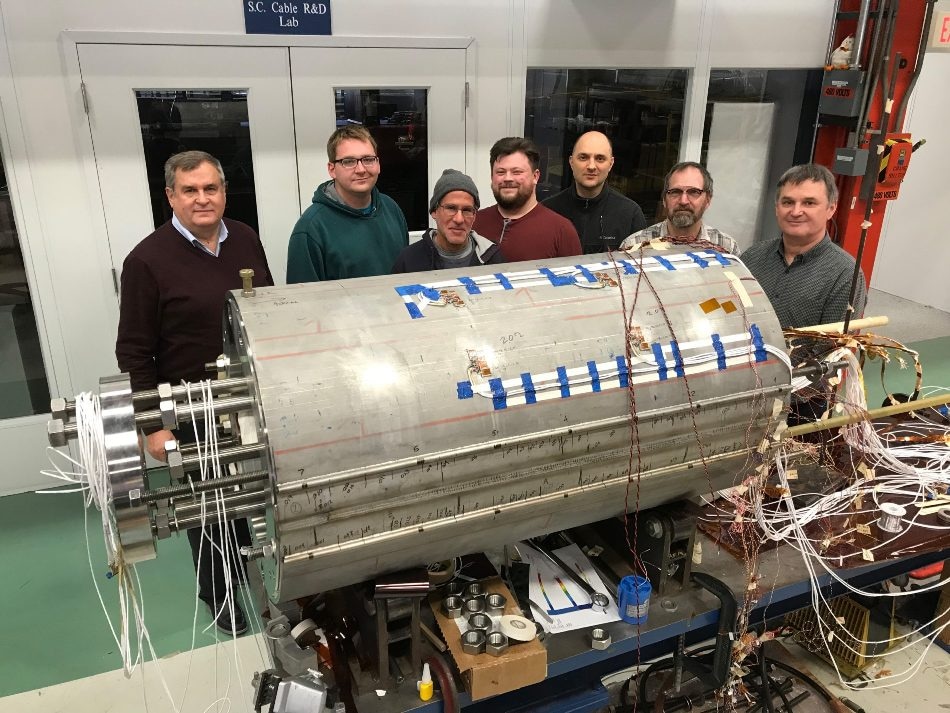Sep 10 2019
Researchers require the strongest magnets possible to create the future generation of robust proton accelerators. This is because they have to steer particles close to the speed of light around a ring.
 Fermilab recently achieved a magnetic field strength of 14.1 T at 4.5 K on an accelerator steering magnet—a world record. (Image credit: Thomas Strauss)
Fermilab recently achieved a magnetic field strength of 14.1 T at 4.5 K on an accelerator steering magnet—a world record. (Image credit: Thomas Strauss)
For a specified ring size, if the energy of the beam is higher, the strength of the accelerator’s magnets must also be higher to maintain the beam on course.
Researchers at the Department of Energy’s Fermilab have reported that they realized the highest magnetic field strength recorded ever for an accelerator steering magnet. By achieving this, they have set a world record of 14.1 T, where the magnet was cooled to 4.5 K or −450 °F. The earlier record of 13.8 T, realized at the same temperature, was held for 11 years by Lawrence Berkeley National Laboratory.
This magnet is over a thousand times stronger than the refrigerator magnet that holds the grocery list to the refrigerator.
The achievement is a noteworthy landmark for the particle physics community, which has been analyzing designs for a next-generation collider that could function as a possible successor to the robust 17-mile-around Large Hadron Collider running at CERN laboratory from 2009. A machine such as this would be required to accelerate protons to energies multiple times higher than those at the LHC.
This necessitates steering magnets that are stronger when compared to that of the LHC, about 15 T.
“We’ve been working on breaking the 14-tesla wall for several years, so getting to this point is an important step,” stated Fermilab scientist Alexander Zlobin, who heads the project at Fermilab. “We got to 14.1 teslas with our 15-tesla demonstrator magnet in its first test. Now we’re working to draw one more tesla from it."
The success of a next-generation high-energy hadron collider is critically dependent on practicable high-field magnets, and the global high-energy physics community has been promoting research aiming at the 15-T niobium-tin magnet.
The core of a magnet’s design is an innovative superconducting material known as niobium-tin.
Electrical current that flows through the material produces a magnetic field. When the material is cooled to extremely low temperatures, the current flows without any resistance, thus it does not lose any energy and produces no heat. All of the current is used up to create the magnetic field. Put differently, lots of magnetic bang is obtained for the electrical buck.
The magnetic field’s strength relies on the current strength that can be handled by the material. In contrast to the niobium-titanium used in the existing LHC magnets, niobium-tin has the potential to support the amount of current required to generate 15-T magnetic fields. However, niobium-tin is brittle and could break upon being subjected to the huge forces at work within an accelerator magnet.
Therefore, the researchers at Fermilab created a magnet design that would guard the coil against every stress and strain it might encounter while it operates. Several dozen round wires were twisted into cables in a specific manner such that it was able to satisfy the needed mechanical and electrical specifications.
The cables were wound into coils. Then, they were heat-treated at higher temperatures for a period of about two weeks, with a peak temperature of around 1,200 °F, to transform the niobium-tin wires into a superconductor at operation temperatures.
The researchers enclosed a number of coils into a robust, novel structure formed of an iron yoke, with a stainless-steel skin and aluminum clamps to stabilize the coils against the enormous electromagnetic forces that can distort the brittle coils, thereby degrading the niobium-tin wires.
The Fermilab team took into account every known design aspect, and the result was successful.
This is a tremendous achievement in a key enabling technology for circular colliders beyond the LHC. This is an exceptional milestone for the international community that develops these magnets, and the result has been enthusiastically received by researchers who will use the beams from a future collider to push forward the frontiers of high-energy physics.
Soren Prestemon, Senior Scientist, Lawrence Berkeley National Laboratory
Prestemon is also the director of the multilaboratory U.S. Magnet Development Program, which includes the Fermilab team. The Fermilab researchers are ready to make their mark in the 15-T domain.
There are so many variables to consider in designing a magnet like this: the field parameters, superconducting wire and cable, mechanical structure and its performance during assembly and operation, magnet technology, and magnet protection during operation. All of these issues are even more important for magnets with record parameters.
Alexander Zlobin, Scientist, Fermilab
In the next few months, the team intends to strengthen the mechanical support of the coil and subsequently retest the magnet in fall 2019. They are hopeful that the 15-T design goal can be achieved. With this in mind, they are setting sights on a higher value for the further future.
Based on the success of this project and the lessons we learned, we’re planning to advance the field in niobium-tin magnets for future colliders to 17 teslas.
Alexander Zlobin
The research does not cease here. According to Zlobin, they may be able to develop steering magnets that attain a field of 20 T with the help of specialized inserts made using novel, state-of-the-art superconducting materials.
This can be called a field goal.
The research is supported by the Department of Energy Office of Science. It is a key part of the U.S. Magnet Development Program, which includes Fermilab, Lawrence Berkeley National Laboratory, Brookhaven National Laboratory, and the National High Magnetic Field Laboratory.